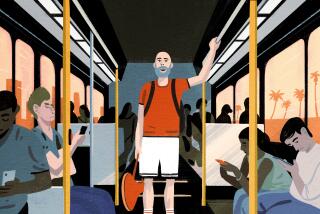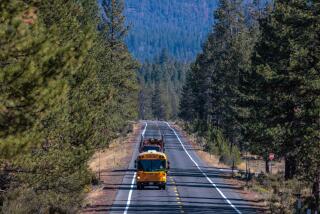Plain-Wrap Network Hits Road in High-Tech Bus : C-SPAN: Recruiting viewers, especially teachers and students, is its aim. With turmoil in the cable industry, there’s a lot riding on those big wheels.
ST. PETERSBURG, Fla. — Margie Grills charged toward the canary yellow bus with “C-SPAN” emblazoned across its side. “Is Brian in there?” she squealed before she reached the first step up.
Brian Lamb--C-SPAN founder and self-styled anti-celebrity--is back in Washington. Disappointed, Grills, 64, scrambled aboard anyway, oohing and ahhing over the TV cameras and video monitors inside.
The bus crisscrossing the country is the first flashy promotion since cable TV’s low-budget public service network debuted March 19, 1979. C-SPAN is the network that dares to be dull, the network that brought you two hours of Congress members arguing about mohair subsidies.
Grills is the kind of fan they love to meet.
A resident of Bella Vista, Ark., who is spending the winter in Florida, she calls herself a “C-SPAN junkie.” She isn’t interested in ABC or CNN--the way they snip the news into sound bites, then trot out commentators to tell her what it means. She watches Congress live on C-SPAN for hours at a time.
“I like it,” she said, “because it’s not all gussied up.”
Exactly. C-SPAN has made a science of being less than lively, more solid than slick. Its unblinking cameras stare straight through congressional hearings, speeches, political rallies and press conferences.
There are no commercials or ratings; no catchy theme songs or celebrity hosts or wizened commentators.
Lamb--who doubles as on-air moderator and chief executive officer--has attracted a few fans like Grills despite his efforts to avoid celebrity. But he refuses to promote himself or the other on-air hosts: their place is in the background.
That has made it tough to promote C-SPAN. Without an image to market, how could the network reach out to potential viewers--especially teachers and students--who could benefit from its programming?
Enter the C-SPAN School Bus.
Other networks plug a Dan Rather or Diane Sawyer; C-SPAN has its bus. “Because this is a network without personalities,” Lamb explained, “the bus is our personality.”
The idea came to him in February, 1993, while interviewing author and history professor Douglas Brinkley, who traveled the country in a bus with 17 students.
Nine months later, the $500,000 C-SPAN bus was on the road--part rolling billboard, part classroom, part television studio. It’s still out there, in the midst of a 35-state tour from Washington to California to Florida to Massachusetts.
At a time of turmoil in the cable industry, there’s a lot riding on those eight big wheels. “It’s a good time to be on the road,” C-SPAN Vice President Susan Swain said.
New federal cable regulations cost C-SPAN about 2.5 million households since September. The rules require cable systems to carry more broadcast stations in their lineups, and some dumped C-SPAN to make room.
Ironically, Congress had struck a blow against its direct pipeline into the nation’s living rooms. “I don’t think they have any idea how bad it’s hurt the underpinnings of this network,” Lamb said.
C-SPAN has joined others in challenging the regulations before the Supreme Court. In the fast-changing world of cable TV, Lamb said, “my No. 1 goal is survival.”
Just 15 years old, C-SPAN already has the feel of an institution. Its live coverage of the House of Representatives reaches 50 million cable households--about 98% of the homes with cable--plus another 10 million by satellite.
C-SPAN 2, which covers the Senate, reaches more than 30 million homes. A third network is to begin airing part time this month, carrying more speeches and hearings to a handful of markets.
Lamb said that surveys find four in 10 cable viewers watch C-SPAN.
In St. Petersburg, Fla., as in most other cities on the trip, the bus pulled up outside a school. Eleven students crowded onto a couch inside, in front of three large video monitors. When asked if they ever watch C-SPAN, two of them nodded.
Bus manager Richard Weinstein showed off the robotic cameras, zooming in on one girl to demonstrate how close-ups create a sense of drama.
“At C-SPAN, we try to be neutral--even technically,” he told the students.
“If someone is giving a speech on the House floor, whether he’s talking about something really boring or something really important--that’s for you to decide,” Weinstein said as students watched their faces staring back from the video monitors.
To the teachers, the bus handed out information on how to use C-SPAN in the classroom, for free. Some already knew. Jacksonville, Fla., teacher Kevin Sacerdote said C-SPAN gives his government students a look at the British House of Commons, the nightly news from Moscow and the Australian Parliament.
“The kids have a sense of ‘Wow!’ about it, but ‘Wow!’ doesn’t last,” said C-SPAN’s Swain, who joined the bus for a few days. “It’s important to turn a couple of teachers at every stop into users, so it’s there for the long haul.”
Video shot by the bus crew shows up on C-SPAN daily. One day it’s the Nixon Presidential Library in Yorba Linda, Calif.; another it’s the Cadillac Ranch in Amarillo, Tex., or a blimp ride in Orlando, Fla.
With the help of a satellite truck, the bus can do live interviews. Ross Perot came aboard in Texarkana, Tex., and President Clinton spoke to the bus by telephone in Hot Springs, Ark.
The tour will end in New Orleans in May. C-SPAN expects the bus to be back on the road to schools next fall, and in years to come. There’s talk of painting it red, white and blue for the ’96 elections.
“If you change the oil,” Swain said, “this thing can go forever.”
More to Read
The biggest entertainment stories
Get our big stories about Hollywood, film, television, music, arts, culture and more right in your inbox as soon as they publish.
You may occasionally receive promotional content from the Los Angeles Times.










